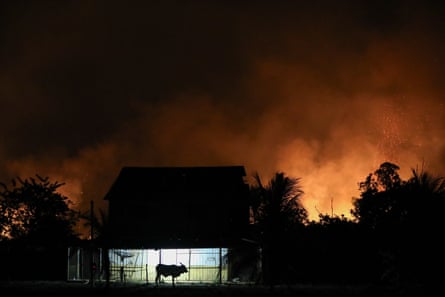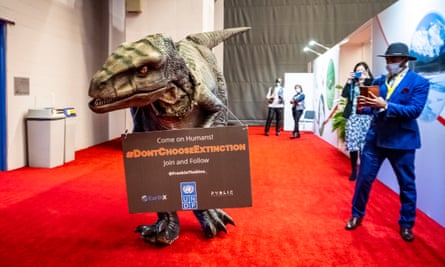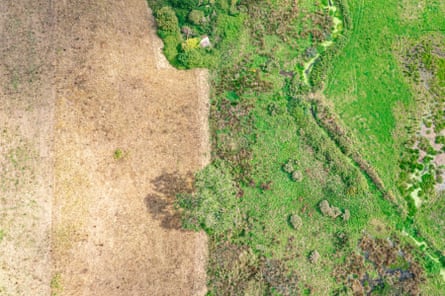As the Cop16 conference begins, scientists and academics say human activity has pushed the world into a danger zone
The age of extinction is supported by About this content
About this content Phoebe WestonMon 21 Oct 2024 01.00 EDTLast modified on Mon 21 Oct 2024 01.01 EDTShareHumanity is “on the precipice” of shattering Earth’s limits, and will suffer huge costs if we fail to act on biodiversity loss, experts warn. This week, world leaders meet in Cali, Colombia, for the Cop16 UN biodiversity conference to discuss action on the global crisis. As they prepare for negotiations, scientists and experts around the world have warned that the stakes are high, and there is “no time to waste”.
Phoebe WestonMon 21 Oct 2024 01.00 EDTLast modified on Mon 21 Oct 2024 01.01 EDTShareHumanity is “on the precipice” of shattering Earth’s limits, and will suffer huge costs if we fail to act on biodiversity loss, experts warn. This week, world leaders meet in Cali, Colombia, for the Cop16 UN biodiversity conference to discuss action on the global crisis. As they prepare for negotiations, scientists and experts around the world have warned that the stakes are high, and there is “no time to waste”.
“We are already locked in for significant damage, and we’re heading in a direction that will see more,” says Tom Oliver, professor of applied ecology at the University of Reading. “I really worry that negative changes could be very rapid.”
<strong>What is Cop16?</strong></p><p>From 21 October until 1 November, governments will meet in Cali, Colombia, for a summit on the state of biodiversity and nature. Representatives of almost 200 countries will negotiate over how to protect the planet from mass extinctions and ecosystem breakdown. The gathering is formally known as the 16th conference of the parties of the UN convention on biological diversity – shortened to Cop16. It will be the first time countries have met since they formed a landmark nature-protection deal at <a href=\"https://www.theguardian.com/environment/cop15\">Cop15</a> in Montreal, Canada, in December 2022. </p><p><strong>What will they be negotiating over?</strong></p><p>In Montreal, countries agreed a landmark deal to save nature. Cop16 will be about whether they are putting that into practice. The main focus will be on progress on <a href=\"https://www.cbd.int/article/cop15-cbd-press-release-final-19dec2022\">23 biodiversity targets</a> for this decade. They include a high-profile goal to protect 30% of the Earth for nature by the end of the decade, restore 30% of the planet’s most degraded ecosystems and reform some of the economic drivers of the loss. Countries will also be discussing how to fund these protections.</p><p><strong>What is at stake?</strong></p><p>Nature is in crisis: global wildlife populations have plunged by an average of <a href=\"https://www.theguardian.com/environment/2024/oct/10/collapsing-wildlife-populations-points-no-return-living-planet-report-wwf-zsl-warns\">73% in 50 years</a>, according to a scientific assessment made in October 2024. The biodiversity crisis is not just about other species – humans also rely on the natural world for food, clean water and air to breathe. On the eve of Cop16, land restoration expert Tonthoza Uganja said: ‘We are on the precipice of shattering Earth’s natural limits – we have not gone there yet, but we are right on the edge.'</p>","credit":""}”>Quick GuideWhat is Cop16 and why does it matter?ShowWhat is Cop16?
From 21 October until 1 November, governments will meet in Cali, Colombia, for a summit on the state of biodiversity and nature. Representatives of almost 200 countries will negotiate over how to protect the planet from mass extinctions and ecosystem breakdown. The gathering is formally known as the 16th conference of the parties of the UN convention on biological diversity – shortened to Cop16. It will be the first time countries have met since they formed a landmark nature-protection deal at Cop15 in Montreal, Canada, in December 2022.
What will they be negotiating over?
In Montreal, countries agreed a landmark deal to save nature. Cop16 will be about whether they are putting that into practice. The main focus will be on progress on 23 biodiversity targets for this decade. They include a high-profile goal to protect 30% of the Earth for nature by the end of the decade, restore 30% of the planet’s most degraded ecosystems and reform some of the economic drivers of the loss. Countries will also be discussing how to fund these protections.
What is at stake?
Nature is in crisis: global wildlife populations have plunged by an average of 73% in 50 years, according to a scientific assessment made in October 2024.The biodiversity crisis is not just about other species – humans also rely on the natural world for food, clean water and air to breathe. On the eve of Cop16, land restoration expert Tonthoza Uganja said: ‘We are on the precipice of shattering Earth’s natural limits – we have not gone there yet, but we are right on the edge.’
Was this helpful?Thank you for your feedback.Since 1970, some studies estimate wildlife populations have declined on average by 73%, with huge numbers lost in the decades and centuries before. Passenger pigeons, the Carolina parakeets and Floreana giant tortoises are among the many species humans have obliterated. “It’s shameful that our single species is driving the extinction of thousands of others,” says Oliver.
 View image in fullscreenExtinction Rebellion activists highlight declines in bird numbers. Photograph: Ben Stansall/AFP/Getty ImagesThe biodiversity crisis is not just about other species – humans also rely on the natural world for food, clean water and air to breathe. Oliver says: “I think we will, certainly, in the next 15 to 20 years, see continued food crises, and the real risk of multiple breadbasket failures … that’s in addition to a lot of the other risks that might impact us through fresh-water pollution, ocean acidification, wildfire and algal blooms, and so on.”
View image in fullscreenExtinction Rebellion activists highlight declines in bird numbers. Photograph: Ben Stansall/AFP/Getty ImagesThe biodiversity crisis is not just about other species – humans also rely on the natural world for food, clean water and air to breathe. Oliver says: “I think we will, certainly, in the next 15 to 20 years, see continued food crises, and the real risk of multiple breadbasket failures … that’s in addition to a lot of the other risks that might impact us through fresh-water pollution, ocean acidification, wildfire and algal blooms, and so on.”
We will see massive functional shifts that will impact humanityAndrew Terry, Zoological Society of LondonOliver, who is working with the UK government to identify “chronic risks” to the world, was involved in a 2024 report that showed nature degradation could cause a 12% loss to UK GDP. Disease outbreaks, loss of insects to pollinate crops, collapse of fisheries and flooding were among the risks identified. He says we are in an era of mass extinction with “huge uncertainty in where the safe limits are”.
Scientists say human activity has pushed the world into the danger zone in seven out of eight indicators of planetary safety. Under a business-as-usual scenario, biodiversity loss will accelerate, with more species surviving only in zoos.
 View image in fullscreenForest fires caused by illegal burning in the Amazon rainforest in Amazonas state, northern Brazil in September 2024. Photograph: Michael Dantas/AFP/Getty ImagesEnvironmental breakdown is driving inequality, conflict and injustice. Dr Andrew Terry, director of conservation and policy at the Zoological Society of London (ZSL), says: “Already, we have witnessed environmentally driven famine in Madagascar and mass migration. We will see increased conflict for access to dwindling resources, particularly water and food. We will see increases in major health issues, particularly [due to] urban heat as temperatures increase to intolerable levels and pollution rises.”
View image in fullscreenForest fires caused by illegal burning in the Amazon rainforest in Amazonas state, northern Brazil in September 2024. Photograph: Michael Dantas/AFP/Getty ImagesEnvironmental breakdown is driving inequality, conflict and injustice. Dr Andrew Terry, director of conservation and policy at the Zoological Society of London (ZSL), says: “Already, we have witnessed environmentally driven famine in Madagascar and mass migration. We will see increased conflict for access to dwindling resources, particularly water and food. We will see increases in major health issues, particularly [due to] urban heat as temperatures increase to intolerable levels and pollution rises.”
Experts warn that ecosystems are starting to approach tipping points – where they shift into a new, degraded state that further reduces their resilience. Terry says: “This will see once rich, wet tropical areas become dry savannahs, or warming ocean currents completely change. This is where we will see massive functional shifts that will impact humanity.”
A loss of connection to the EarthAll over the world, people are noticing nature and species disappearing in the space of a few generations. Tonthoza Uganja is a land restoration expert from Yesaya village in central Malawi, a forest-dependent community with people traditionally eating mushrooms and berries from the wood for sustenance, and using trees for shelter. “We relied on a biodiverse ecosystem to thrive,” says Uganja. But in the past few generations this abundance of nature has dramatically declined. “If you see the changes, they are tremendous. It’s insane,” says Uganja, who is completing a PhD on farming systems and climate change at Bangor University in Wales.
If you see the changes, they’re tremendous. It’s insaneTonthoza Uganja, land restoration expert“People’s livelihoods are at the centre of this,” she says. “Biodiversity loss looks complex, but at the end of the day, it comes back to life. As we lose biodiversity, it’s essentially losing parts of ourselves as human beings as well.”
Her comments were echoed in a report by the Intergovernmental Science-Policy Platform on Biodiversity and Ecosystem Services (Ipbes), which found a market-based focus on economic growth meant the wider benefits of nature – including spiritual, cultural and emotional value – had been ignored.
If we don’t act, Uganja says, “it will be a planet where we have lost our history, because our nature is our history. We’ve lost not just key species – we’ve lost our connectivity to the Earth.”
In central Malawi, Uganja says threats are multiplying, with changing weather systems making crop failures more common. “Climate change has devastating effects. It is bringing a huge shock wave in communities.
“We are on the precipice of shattering Earth’s natural limits – we have not gone there yet, but we are right on the edge.”
A need for urgencyScientists say the biodiversity crisis must be treated as urgently as climate. There is up to eight times more media coverage of the climate crisis relative to biodiversity loss, but Alexandre Antonelli, the director of science at Kew’s Royal Botanic Gardens in London, believes a shift is occurring. “Every company leader and politician I talk to today, from many countries and backgrounds, seems to recognise the urgency of halting biodiversity loss, and appears genuinely interested in doing something concrete about it. This wasn’t the case five years ago.”
We need to restore that bedrock of pro-natural values so we don’t have this casual attitude to ecocideTom Oliver, University of ReadingFor many, Cop16 is an opportunity for global leaders to meet and compare their proposed actions to protect biodiversity. So far, governments have never met any of their self-imposed targets on nature loss, and experts say that must change urgently. There is “no time to waste”, says Mike Hoffman, ZSL’s head of wildlife recovery. “We cannot just sit by and document loss; we have to act, working with governments, other NGOs, the private sector and communities, to disrupt that trajectory of loss.”
 View image in fullscreenFrankie the Dino, the United Nations Development Programme’s climate mascot, at Cop15 in Montreal, Canada, in 2022. Photograph: Environment and Climate Change CanadaKey issues to be discussed at Cop16 include whether wealthy countries will meet their target of contributing a minimum of $20bn annually for low and middle-income countries by 2025, as well as all nations outlining their domestic targets to protect biodiversity – less than 20% had done so ahead of the meeting.
View image in fullscreenFrankie the Dino, the United Nations Development Programme’s climate mascot, at Cop15 in Montreal, Canada, in 2022. Photograph: Environment and Climate Change CanadaKey issues to be discussed at Cop16 include whether wealthy countries will meet their target of contributing a minimum of $20bn annually for low and middle-income countries by 2025, as well as all nations outlining their domestic targets to protect biodiversity – less than 20% had done so ahead of the meeting.
Oliver believes the root causes of biodiversity loss lie in our worldviews – and this is also where he believes the solutions will be. Changing the “juggernaut” of destruction means changing the way our economy is run and how the education system works, right down to our mindsets and the way we see ourselves as “locked into this degradation”.
“I think the only way we can start to address that mass extinction is if we have more humility in our relationship as part of just one other species in the web of life,” he says. “We have lost that bedrock of pro-nature values … We need to restore that so we don’t have this casual attitude to ecocide.”
Nature restoration not a ‘nice to have’Many governments are failing to prioritise nature restoration. In August, a study found that butterflies, bees and bats were among wildlife being boosted by the UK’s nature-friendly farming schemes. The following month it was revealed the Labour government would be slashing the nature-friendly farming budget in England by £100m to help fill what ministers say is a £22bn shortfall.
 View image in fullscreenA drone image shows the benefits beavers have had in maintaining an area of wetland during a drought, Clinton Devon Estates, UK. Photograph: Clinton Devon EstatesProf Rob Brooker, head of ecological sciences at the James Hutton Institute, says it is frustrating to see governments deprioritise nature conservation because of financial constraints. “Biodiversity is not a ‘nice to have’ – it is a critical element of delivering action on climate change, health and wellbeing, and sustainable food production,” he says. “Without action, our planet will be further depleted in the decades to come. We will have more hungry people living in a world with a less stable climate, and more extreme weather events.”
View image in fullscreenA drone image shows the benefits beavers have had in maintaining an area of wetland during a drought, Clinton Devon Estates, UK. Photograph: Clinton Devon EstatesProf Rob Brooker, head of ecological sciences at the James Hutton Institute, says it is frustrating to see governments deprioritise nature conservation because of financial constraints. “Biodiversity is not a ‘nice to have’ – it is a critical element of delivering action on climate change, health and wellbeing, and sustainable food production,” he says. “Without action, our planet will be further depleted in the decades to come. We will have more hungry people living in a world with a less stable climate, and more extreme weather events.”
It has really big effects on society – it’s not just about being able to see some butterfliesRick Stafford, Bournemouth UniversityProf Rick Stafford from Bournemouth University, who is chair of the British Ecological Society policy committee, says he has watched the decline of key species he studies in his own lifetime. He first went diving with sharks on the reefs of Indonesia 20 years ago. Now, “they’ve completely vanished, not just in Indonesia but other places”. Their absence is the “new normal”, he says, but it can have cascading effects for marine ecosystems.
Coral reefs are important fish nurseries and help feed more than 500 million people worldwide. Stafford agrees that biodiversity is not just “a ‘nice to have’ thing”. “It’s actually an essential thing,” he says.
He says people don’t understand the urgency of it. “We are very close to those sort of critical limits where we are not going to be able to recover that biodiversity, and it has really big effects on society – it is not just about being able to see some butterflies.”
Find more age of extinction coverage here, and follow biodiversity reporters Phoebe Weston and Patrick Greenfield on X for all the latest news and features